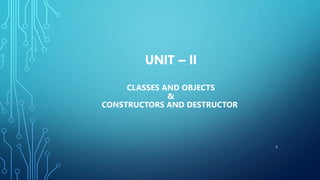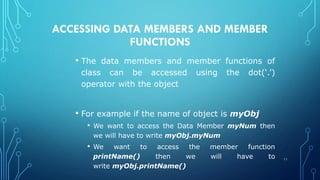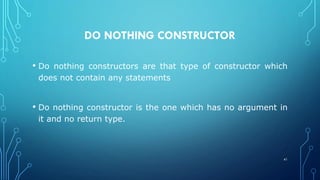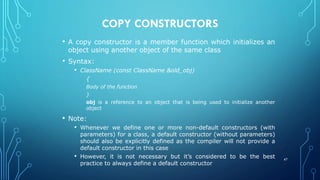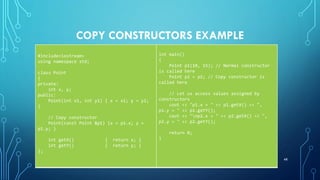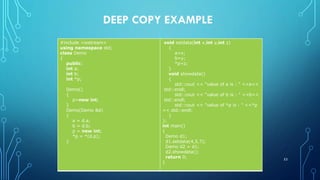Object Oriented Programming using C++ - Part 2
- 1. OOPS THROUGH C++ 1 Dr. Chandra Sekhar Sanaboina Assistant Professor Department of Computer Science and Engineering University College of Engineering Kakinada Jawaharlal Nehru Technological University Kakinada Website: https://drcs.info Youtube Link: https://www.youtube.com/watch?v=nPjHraTbPeY&list=PLT1ngltOnlJiHbzVvjkU8VzQt9oam8ji4
- 2. UNIT – II CLASSES AND OBJECTS & CONSTRUCTORS AND DESTRUCTOR 2
- 3. AGENDA • Classes and Objects • Classes in C++ • Declaring Objects • Access Specifiers and their Scope • Defining Member Function • Overloading Member Function • Nested class • Constructors and Destructors • Introduction • Characteristics of Constructor and Destructor • Application with Constructor • Constructor with Arguments (parameterized Constructors) • Destructors 3
- 5. CLASSES IN C++ • C++ is an object-oriented programming language • Everything in C++ is associated with classes and objects • A class in C++ is the building block, that leads to Object- Oriented programming • It is a user-defined data type • Holds its own Data Members and Member Functions • Data Members are the data variables • Member Functions are the functions used to manipulate these variables • Note: The Data Members and Member Functions defines the properties and behavior of the objects in a Class. • Data members and Member Functions can be accessed and used by creating an instance of that class • A C++ class is like a blueprint for an object 5
- 6. CLASSES IN C++ CONTD… • Creating a Class • Syntax: class <class_name> { Access Specifiers: Data_Members; Member_Functions(); }; • Explanation to class creation in C++ • class keyword is used to create a class • <class_name> specifies the name of the class • The body of class is defined inside the curly brackets • Inside the class we can declare the desired data members and member functions with desired Access Specifiers • The class should always end with a semicolon (;) 6
- 7. CLASSES IN C++ CONTD… • Example: class MyClass { // The class public: // Access specifier int myNum; // Attribute (int variable) float myFloat; // Attribute (float variable) }; • Explanation to class creation in C++ • class keyword is used to create a class • MyClass specifies the name of the class • The public keyword is an Access Specifier • Inside the class we have declared two Data Members (Called as Attributes) • myNum of integer datatype • myFloat of Float datatype • The class should always end with a semicolon (;) 7
- 9. OBJECTS IN C++ • An Object is an instance of a Class • When a class is defined, no memory is allocated but when it is instantiated (i.e. an object is created) memory is allocated • To use the data and access functions defined in the class, we need to create the objects • Declaring Objects: • Syntax: • Classname object_name • Example: • MyClass myObj; • MyClass is the class name • myObj is the name of the object 9
- 10. ACCESSING THE DATA MEMBERS AND MEMBER FUNCTIONS 10
- 11. ACCESSING DATA MEMBERS AND MEMBER FUNCTIONS • The data members and member functions of class can be accessed using the dot(‘.’) operator with the object • For example if the name of object is myObj • We want to access the Data Member myNum then we will have to write myObj.myNum • We want to access the member function printName() then we will have to write myObj.printName() 11
- 12. EXAMPLE PROGRAM CREATING SINGLE OBJECT class MyClass { // The class public: // Access specifier int myNum; // Attribute (int variable) string myString; // Attribute (string variable) }; int main() { MyClass myObj; // Create an object of MyClass // Access attributes and set values myObj.myNum = 15; myObj.myString = “Chandu"; // Print attribute values cout << myObj.myNum << "n"; cout << myObj.myString; return 0; } 12
- 13. EXAMPLE PROGRAM CREATING MULTIPLE OBJECTS // Create a Car class with some attributes class Car { public: string brand; string model; int year; }; int main() { // Create an object of Car Car carObj1; carObj1.brand = "BMW"; carObj1.model = "X5"; carObj1.year = 1999; // Create another object of Car Car carObj2; carObj2.brand = "Ford"; carObj2.model = "Mustang"; carObj2.year = 1969; // Print attribute values cout << carObj1.brand << " " << carObj1.model << " " << carObj1.year << "n"; cout << carObj2.brand << " " << carObj2.model << " " << carObj2.year << "n"; return 0; } 13
- 15. ACCESS SPECIFIERS AND THEIR SCOPE • Data hiding is one of the important features of Object Oriented Programming which allows preventing the functions of a program to access directly the internal data members of a class • The access restriction to the class members is specified by the labeled • Public • Private, and • protected • These labels are called as Access Specifiers • Note 1: A class can have multiple public, protected, or private labeled sections • Note 2: Each section remains in effect until either another section label or the closing right brace of the class body is seen • Note 3: The default access for members and classes is private 15
- 16. ACCESS SPECIFIERS EXAMPLE • Example – Class Base { public: //Public Members go here private: //Private Members go here protected: //Protected Members go here }; 16
- 18. PUBLIC ACCESS SPECIFIER • A public member is accessible from anywhere outside the class but within a program • You can set and get the value of public variables without any member function 18
- 19. PUBLIC ACCESS SPECIFIER EXAMPLE #include <iostream> using namespace std; class Line { public: double length; void setLength( double len ); double getLength( void ); }; // Member functions definitions double Line::getLength(void) { return length ; } void Line::setLength( double len) { length = len; } // Main function for the program int main() { Line line; // set line length line.setLength(6.0); cout << "Length of line : " << line.getLength() <<endl; // set line length without member function line.length = 10.0; // OK: because length is public cout << "Length of line : " << line.length <<endl; return 0; } 19
- 21. PRIVATE ACCESS SPECIFIER • A private member variable or function cannot be accessed, or even viewed from outside the class • Only the class and friend functions can access private members • By default all the members of a class would be private • which means until you label a member, it will be assumed a private member • Practically, we define data in private section and related functions in public section so that they can be called from outside of the class 21
- 22. PRIVATE ACCESS SPECIFIER EXAMPLE class Box { double width; public: double length; void setWidth( double wid ); double getWidth( void ); }; 22
- 23. PRIVATE ACCESS SPECIFIER EXAMPLE #include <iostream> using namespace std; class Box { public: double length; void setWidth( double wid ); double getWidth( void ); private: double width; }; // Member functions definitions double Box::getWidth(void) { return width ; } void Box::setWidth( double wid ) { width = wid; } // Main function for the program int main() { Box box; // set box length without member function box.length = 10.0; // OK: because length is public cout << "Length of box : " << box.length <<endl; // set box width without member function // box.width = 10.0; // Error: because width is private box.setWidth(10.0); // Use member function to set it. cout << "Width of box : " << box.getWidth() <<endl; return 0; } 23
- 25. PROTECTED ACCESS SPECIFIER • A protected member variable or function is very similar to a private member but it provided one additional benefit that they can be accessed in child classes which are called derived classes 25
- 26. PROTECTED ACCESS SPECIFIER EXAMPLE #include <iostream> using namespace std; class Box { protected: double width; }; class SmallBox:Box { // SmallBox is the derived class. public: void setSmallWidth( double wid ); double getSmallWidth( void ); }; // Member functions of child class double SmallBox::getSmallWidth(void) { return width ; } void SmallBox::setSmallWidth( double wid ) { width = wid; } // Main function for the program int main() { SmallBox box; // set box width using member function box.setSmallWidth(5.0); cout << "Width of box : "<< box.getSmallWidth() << endl; return 0; } 26
- 28. DEFINING MEMBER FUNCTION • A member function of a class is a function that has its definition or its prototype within the class definition like any other variable • It operates on any object of the class of which it is a member, and has access to all the members of a class for that object • There are 2 ways to define a member function: • Inside class definition • Outside class definition 28
- 29. DEFINING MEMBER FUNCTIONS INSIDE THE CLASS DEFINITION • Defining a member function within the class definition declares the function inline, even if you do not use the inline specifier class Box { public: double length; // Length of a box double breadth; // Breadth of a box double height; // Height of a box double getVolume(void) { return length * breadth * height; } }; 29
- 30. DEFINING MEMBER FUNCTIONS OUTSIDE THE CLASS DEFINITION • To define a member function outside the class definition we have to use the scope resolution :: operator along with class name and function name • We have to use class name just before :: operator class Box { public: double length; // Length of a box double breadth; // Breadth of a box double height; // Height of a box double getVolume(void); }; double Box :: getVolume(void) { return length * breadth * height; } • A member function will be called using a dot operator (.) on a object where it will manipulate data related to that object Box myBox(); myBox.getVolume(); 30
- 31. PROGRAMMING EXAMPLE #include <iostream> using namespace std; class Box { public: double length; // Length of a box double breadth; // Breadth of a box double height; // Height of a box // Member functions declaration double getVolume(void); void setLength( double len ); void setBreadth( double bre ); void setHeight( double hei ); }; // Member functions definitions double Box::getVolume(void) { return length * breadth * height; } void Box::setLength( double len ) { length = len; } void Box::setBreadth( double bre ) { breadth = bre; } void Box::setHeight( double hei ) { height = hei; } // Main function for the program int main() { Box Box1; // Declare Box1 of type Box Box Box2; // Declare Box2 of type Box double volume = 0.0; // Store the volume of a box here // box 1 specification Box1.setLength(6.0); Box1.setBreadth(7.0); Box1.setHeight(5.0); // box 2 specification Box2.setLength(12.0); Box2.setBreadth(13.0); Box2.setHeight(10.0); // volume of box 1 volume = Box1.getVolume(); cout << "Volume of Box1 : " << volume <<endl; // volume of box 2 volume = Box2.getVolume(); cout << "Volume of Box2 : " << volume <<endl; return 0; } 31
- 33. OVERLOADING MEMBER FUNCTION • We can have multiple definitions for the same function name in the same scope • The definition of the function must differ from each other by the types and/or the number of arguments in the argument list • We cannot overload function declarations that differ only by return type 33
- 34. OVERLOADING MEMBER FUNCTIONS EXAMPLE #include <iostream> using namespace std; class printData { public: void print(int i) { cout << "Printing int: " << i << endl; } void print(double f) { cout << "Printing float: " << f << endl; } void print(char* c) { cout << "Printing character: " << c << endl; } }; int main(void) { printData pd; // Call print to print integer pd.print(5); // Call print to print float pd.print(500.263); // Call print to print character pd.print("Hello C++"); return 0; } 34
- 36. NESTED CLASS • A nested class is a class that is declared in another class • The nested class is also a member variable of the enclosing class and has the same access rights as the other members • However, the member functions of the enclosing class have no special access to the members of a nested class 36
- 37. NESTED CLASS EXAMPLE #include<iostream> using namespace std; class A { public: class B { private: int num; public: void getdata(int n) { num = n; } void putdata() { cout<<"The number is "<<num; } }; }; int main() { cout<<"Nested classes in C++"<< endl; A :: B obj; obj.getdata(9); obj.putdata(); return 0; } 37
- 39. CONSTRUCTORS AND DESTRUCTORS • Introduction • It is special member function of the class. • Constructors are special class members which are called by the compiler every time an object of that class is instantiated • In C++, Constructor is automatically called when object (instance of class) is created • Constructors have the same name as the class • Constructors may be defined inside or outside the class definition • There are 4 types of constructors: • Do Nothing Constructor • Default constructors • Parametrized constructors • Copy constructors 39
- 40. CONSTRUCTORS VS NORMAL MEMBER FUNCTIONS • A constructor is different from normal functions in following ways: • Constructor has same name as the class itself • Constructors don’t have return type • A constructor is automatically called when an object is created. • If we do not specify a constructor, C++ compiler generates a default constructor for us (expects no parameters and has an empty body). 40
- 41. DO NOTHING CONSTRUCTOR • Do nothing constructors are that type of constructor which does not contain any statements • Do nothing constructor is the one which has no argument in it and no return type. 41
- 42. DEFAULT CONSTRUCTORS • Default constructor is the constructor which doesn’t take any argument • It has no parameters • Even if we do not define any constructor explicitly, the compiler will automatically provide a default constructor implicitly 42
- 43. DEFAULT CONSTRUCTORS EXAMPLE using namespace std; class construct { public: int a, b; // Default Constructor construct() { a = 10; b = 20; } }; int main() { // Default constructor called automatically // when the object is created construct c; cout << "a: " << c.a << endl << "b: " << c.b; return 1; } 43
- 44. PARAMETERIZED CONSTRUCTORS • It is possible to pass arguments to constructors • Typically, these arguments help initialize an object when it is created • To create a parameterized constructor, simply add parameters to it the way you would to any other function • When you define the constructor’s body, use the parameters to initialize the object 44
- 45. PARAMETERIZED CONSTRUCTORS CONTD… • When an object is declared in a parameterized constructor, the initial values have to be passed as arguments to the constructor function • The normal way of object declaration may not work • The constructors can be called explicitly or implicitly • Explicit Call: Example e = Example(10, 20); • Implicit Call: Example e(10, 20); • Uses of Parameterized constructor: • It is used to initialize the various data elements of different objects with different values when they are created • It is used to overload constructors 45
- 46. PARAMETERIZED CONSTRUCTORS EXAMPLE #include <iostream> using namespace std; class Point { private: int x, y; public: // Parameterized Constructor Point(int x1, int y1) { x = x1; y = y1; } int getX() { return x; } int getY() { return y; } }; int main() { // Constructor called Point p1(10, 15); // Access values assigned by constructor cout << "p1.x = " << p1.getX() << ", p1.y = " << p1.getY(); return 0; } 46
- 47. COPY CONSTRUCTORS • A copy constructor is a member function which initializes an object using another object of the same class • Syntax: • ClassName (const ClassName &old_obj) { Body of the function } obj is a reference to an object that is being used to initialize another object • Note: • Whenever we define one or more non-default constructors (with parameters) for a class, a default constructor (without parameters) should also be explicitly defined as the compiler will not provide a default constructor in this case • However, it is not necessary but it’s considered to be the best practice to always define a default constructor 47
- 48. COPY CONSTRUCTORS EXAMPLE #include<iostream> using namespace std; class Point { private: int x, y; public: Point(int x1, int y1) { x = x1; y = y1; } // Copy constructor Point(const Point &p1) {x = p1.x; y = p1.y; } int getX() { return x; } int getY() { return y; } }; int main() { Point p1(10, 15); // Normal constructor is called here Point p2 = p1; // Copy constructor is called here // Let us access values assigned by constructors cout << "p1.x = " << p1.getX() << ", p1.y = " << p1.getY(); cout << "np2.x = " << p2.getX() << ", p2.y = " << p2.getY(); return 0; } 48
- 49. WHEN IS A USER-DEFINED COPY CONSTRUCTOR NEEDED? • If we don’t define our own copy constructor, the C++ compiler creates a default copy constructor for each class which does a member-wise copy between objects • The compiler created copy constructor works fine in general • We need to define our own copy constructor only if an object has pointers or any runtime allocation of the resource like filehandle, a network connection..etc. • i.e., If the class has pointer variables and has some dynamic memory allocations, then it is a must to have a copy constructor 49
- 50. SHALLOW COPY The Default Copy Constructor does only Shallow Copy 50
- 51. SHALLOW COPY EXAMPLE #include <iostream> using namespace std; class Demo { int a; int b; int *p; public: Demo() { p=new int; } void setdata(int x,int y,int z) { a=x; b=y; *p=z; } void showdata() { std::cout << "value of a is : " <<a<< std::en dl; std::cout << "value of b is : " <<b<< std::en dl; std::cout << "value of *p is : " <<*p<< std:: endl; } }; int main() { Demo d1; d1.setdata(4,5,7); Demo d2 = d1; d2.showdata(); return 0; } 51
- 52. DEEP COPY • Deep copy is possible only with user defined copy constructor • In user defined copy constructor, we make sure that pointers (or references) of copied object point to new memory locations. 52
- 53. DEEP COPY EXAMPLE #include <iostream> using namespace std; class Demo { public: int a; int b; int *p; Demo() { p=new int; } Demo(Demo &d) { a = d.a; b = d.b; p = new int; *p = *(d.p); } void setdata(int x,int y,int z) { a=x; b=y; *p=z; } void showdata() { std::cout << "value of a is : " <<a<< std::endl; std::cout << "value of b is : " <<b<< std::endl; std::cout << "value of *p is : " <<*p << std::endl; } }; int main() { Demo d1; d1.setdata(4,5,7); Demo d2 = d1; d2.showdata(); return 0; } 53
- 54. COPY CONSTRUCTORS CONTD… • Example: myClass t1, t2; myClass t3=t1; t2=t1; • Copy constructor is called when a new object is created from an existing object, as a copy of the existing object • Assignment operator is called when an already initialized object is assigned a new value from another existing object. 54
- 55. COPY CONSTRUCTORS CONTD… • Why argument to a copy constructor must be passed as a reference? • Copy constructor itself is a function • So if we pass an argument by value in a copy constructor, a call to copy constructor would be made to call copy constructor which becomes a non- terminating chain of calls. Therefore compiler doesn’t allow parameters to be passed by value. 55
- 56. COPY CONSTRUCTORS CONTD… • Why copy constructor argument should be const in C++? • When we create our own copy constructor, we pass an object by reference and we generally pass it as a const reference • One reason for passing const reference is, we should use const in C++ wherever possible so that objects are not accidentally modified • This is one good reason for passing reference as const 56
- 57. COPY CONSTRUCTORS CONTD… • Can we make copy constructor private? • Yes, a copy constructor can be made private • When we make a copy constructor private in a class, objects of that class become non-copyable • This is particularly useful when our class has pointers or dynamically allocated resources 57
- 58. CHARACTERISTICS OF CONSTRUCTORS • Characteristics of Constructors • They should be declared in the public section • They do not have any return type, not even void • They get automatically invoked when the objects are created • They cannot be inherited … though derived class can call the base class constructor • Like other functions, they can have default arguments • You cannot refer to their address • Constructors cannot be virtual 58
- 59. DESTRUCTORS • Destructors • Destructor is another special member function that is called by the compiler when the scope of the object ends • As the name implies, destructors are used to destroy the objects that have been created by the constructor within the C++ program • Destructor names are same as the class name but they are preceded by a tilde (~) • It is a good practice to declare the destructor after the end of using constructor • The destructor neither takes an argument nor returns any value • The compiler implicitly invokes upon the exit from the program for cleaning up storage that is no longer accessible • Here's the basic declaration procedure of a destructor: • ~classname() { } 59
- 60. CHARACTERISTICS OF DESTRUCTORS • Characteristics of Destructors • The destructor has the same name as that of the class prefixed by the tilde character ‘~’ • The destructor cannot have arguments • It has no return type • Destructors cannot be overloaded i.e., there can be only one destructor in a class • In the absence of user defined destructor, it is generated by the compiler • The destructor is executed automatically when the control reaches the end of class scope to destroy the object • They cannot be inherited 60
- 61. THE END 61


